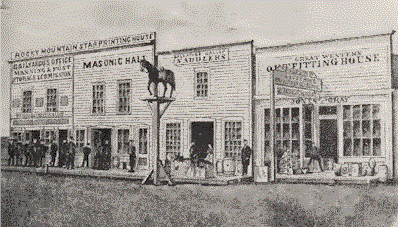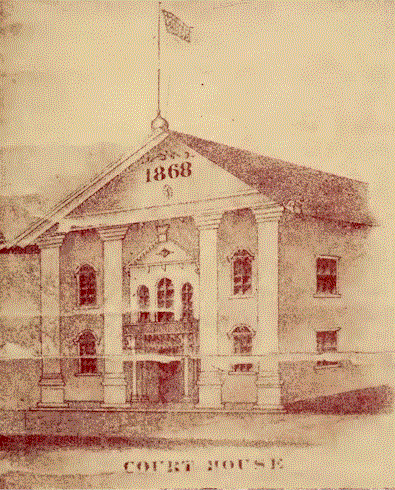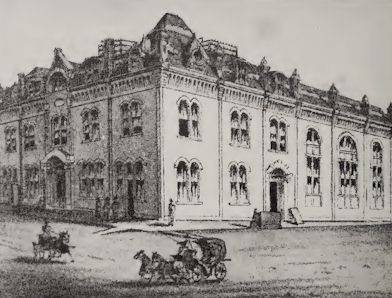Buildings in Cheyenne, Dakota Territory, 1867
 |
|
The buildings included in the
sketch above, built in 1867, were the first to be built
on the northeast corner of Seventeenth street and Carey
avenue (Carey avenue was then Ferguson street)today Garlett's Drug Store and Newberry's occupy these
locations. |

First
Building
Manning and Post, Commission
Merchants, were the owners of this 22x60 two story building
which cost $6,000. They occupied the first floor.
The Daily Rocky Mountain Star which
occupied a part of the second story was first published in
Cheyenne, December 7, 1867. It was Republican in politics,
published by O. T. B. Freeman. The Star lasted about one year.
The Argus made its debut in Cheyenne October 24, 1867, occupying
part of the second story; it was Democratic in politics;
published by L. L. Redell for about two years, later for a few
weeks, by Stanton and Richardson.
Second Building
George Tritch and Co., was the owner
of this two story building 22x60 which cost about $6,000. The
first floor was occupied by Cooper and Preshaw, a storage and
commission house.
The Masonic Hall occupied the second
floor. On February 29, 1868, the Cheyenne Lodge No. 1 A. F. & A.
M. met for the first time in this building.
Third Building
Gallatin d Gallup, saddlers, were the
owners and occupants of this one and a half story frame
building, 20x40, which cost $1,700.
Fourth Building
Jones and Gray, grocers. Were the
owners and occupants of this 20x40, one and a half story frame
building, which cost $4,000.

Cheyenne County Courthouse
There seems
to be no available authentic data on this building. The
photograph is taken from an 1868 map of Cheyenne published by S.
H. Winsor, surveyor and civil engineer. Mr. Winsor included on
this map sketches of early day Cheyenne buildings on the margins
of the map, apparently for decorative purposes.
The Cheyenne Leader, December 31,
1867, mentions that S. H. Winsor was making a map of Cheyenne.
On the map we find that it was approved February 1, 1868 by the
City Council, which included: Mayor, Col. L. Murrin; City
Attorney, W. H. Miller; City Clerk, Ed. Orpen; Council, J. C.
Liddell, M. A. Bodgemen, Dr. J. F. Hamilton, P. McDonald,
William Wise, C. Sternberger; it also states that S. H. Winsor
was City Engineer. Therefore, it is evident that this building
was built in Cheyenne, Dakota Territory in 1867. On January
11th, 1870, there occurred a very destructive fire along
Sixteenth and Eddy streets; the buildings destroyed are listed
in the Cheyenne Daily Leader January 13, 1870 as: T. C. Dickey,
$10,000, no insurance, building occupied as U. S. Court Houses
Messrs. Howe & Steele; U. S. Marshal, District Clerk and
Recorder, U. S. Assessor and Collector, and Judges' Chambers
occupied by J. K. Kingman, Associate Justice."
NOTE: However, we have no assurance
the Court House destroyed by fire, is the one shown.

Cheyenne Opera House, 1882
The Cheyenne
Opera House opened its doors for the first time to a happy
enthusiastic audience composed of people from all over the
Territory, Denver, and neighboring Colorado towns, and Cheyenne,
on May 25, 1882.
After the
audience had assembled and the orchestra had completed its
overture, the curtain was lowered ''amidst the patting of hands
and murmurs of admiration."1
Joseph M.
Carey was called upon for an address, in which he gave the
history of the City as marked by the public buildings; he named
the new opera house as the "third step in an era of progress, a
building in which all the stone used was quarried in our own
County (Laramie) the brick made in our own City (Cheyenne) and
the woodwork carvings and all from the shops of our fellow
townsman, Mr. Weybrecht."2 Mr. Carey
then mentioned what was to be the fourth step in Cheyenne's
progress, stating that in his office safe he had the contract
for all the material for a thorough water works system. This
news was received with great applause.
The formal
dedication of the opera house was reserved for the celebrated
Comley-Barton Opera Company which was enjoyed for three nights
and one matinee. Their opening performance was the charming
French comic opera ''Olivette"; the programs were of perfumed
white satin with bright blue print.
There was
great display of taste and elegance in dress of the audience;
silks and satins appeared in every fashionable shade and color;
large hats and bonnets were substituted for small bonnets, for
it was a gala event. The Opera House was situated on the
northwest corner of Hill (Capitol Ave.) and 17th street. The
building was, as it is today, three stories high. The Opera
House occupied the entire height of the three floors. No
particular style of architecture was followed, several types
being combined, which included Queen Anne, Gothic, Norman and
French roof.
The entrance
to the front of the building was on 17th street; to the right of
this entrance were two large rooms, which were used for the
Territorial Library. The main entrance to the Opera House and
the second floor was on Hill Street (Capitol Ave.). Inside the
Hill street entrance was the ticket office. A large open
stairway built of ash and black walnut, lead to the balcony on
the second floor.
The third
floor was divided into 12 rooms, which were occupied by the
telephone exchange and different lodges.
The theatre
proper, consisted of the parquette, dress circle, gallery or
family circle, "proscenium boxes," inclined stage, orchestra
pit, etc. Four fine boxes adorned either side of the stage; the
parquette, with an inclined floor, was in the form of a half
circle; the dress circle was in the rear of the parquette; above
this was the gallery or family circle. The seats were of the
latest pattern of opera folding chairs. The Theatre seated 860
persons and 1,000 could be comfortably handled. It was heated by
two large furnaces and lighted with gas. An immense 52 light
chandelier hung from the ceiling with a large glass mirror
reflector; single lights with glass globe shades were placed
about the walls; there were two large lights outside of the two
entrances. "By using gas the stage can be darkened at pleasure,
something new, by the way in the history of Cheyenne."3
The
Architects were Messrs. Cooper and Anderson of Cheyenne and
Pueblo (Colorado). J. S. Matthews, their chief draftsman,
supervised the construction.
The interior
of the Opera House was one of magnificence and splendor, the
plain white walls were relieved on the east side by three large
ornamental windows set with cathedral glass, 600 panes being
used in the work. All through the theatre the woodwork was of
maple finish. The parquette and dress circle were separated by a
rail upholstered with red silk plush, the front of the balcony
was protected by a wire screen, a guard rail, also ornamented
with red silk plush. On either side of the stage were four
boxes, each guarded by a heavy bronze rail, which in keeping
with the other upholstering was of heavy red silk plush; the
arches of these boxes were draped with dark red curtains
ornamented with deep fringe and in the rear hung long heavy
white lace curtains. The drop curtain was a scene from the
celebrated Chariot Races by Gerome.
The Cheyenne
Opera House and Library Company was incorporated April 18th,
1881. The company was composed of the prominent men of Cheyenne
and vicinity.
Officers
being J. M. Carey, President; Thomas Sturgis, Vice President;
Isaac Bergman, Secretary and Henry G. Hay, Treasurer. The
management of the opera house was under the control of D. C.
Rhodes, Lessee and Manager, and G. A. Guertin, Assistant
Manager. There were eleven sets of scenery and numerous extras.
Charles S. King, stage carpenter, installed the stage machinery
and scenes. It is interesting to note the number of famous
actors and actresses who performed in the Cheyenne Opera House
in those early days. A few of the most noted ones, were Edwin
Booth, in ''Hamlet," April 18, 1887; Sarah Bernhardt in
"Fedora," June 2, 1887; Lily Langtry in ''A Wife's Peril," June
11, 1887; Madame Modjeska in "Much Ado About Nothing," July 6,
1889; Richard Mansfield in "Beau Brummel," June 22, 1893, and
many others equally famous, too numerous to mention.
The doors of
the Cheyenne Opera House were open for twenty years. May 25,
1882 to December 7, 1902, when the interior of the Opera House
was destroyed by fire.

Footnotes:
1. The Cheyenne Daily
Leader, May 26, 1882.
2. Ibid.
3. Ibid.
Words in parenthesis are inserts.
Back to
Wyoming

Source: Annals of Wyoming, Volume 15,
April 1943, Wyoming Historical Department, Cheyenne, Wyoming.
|



